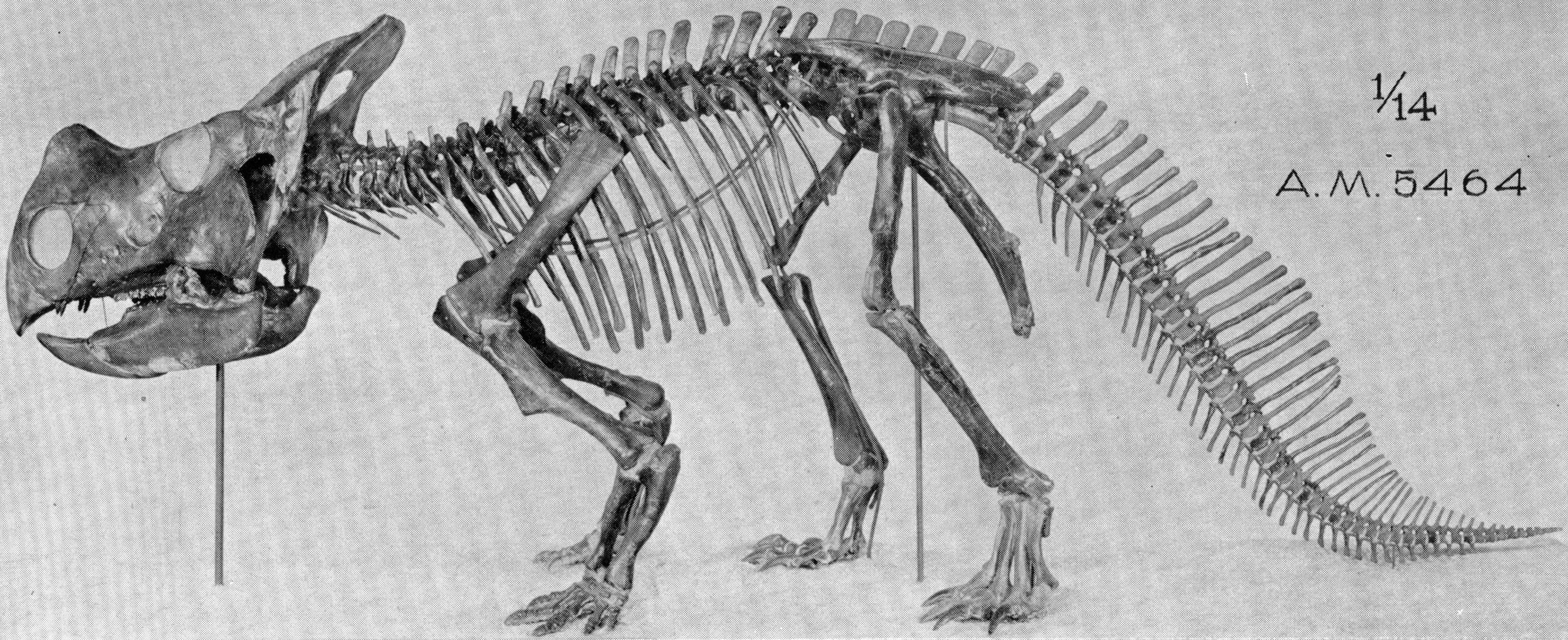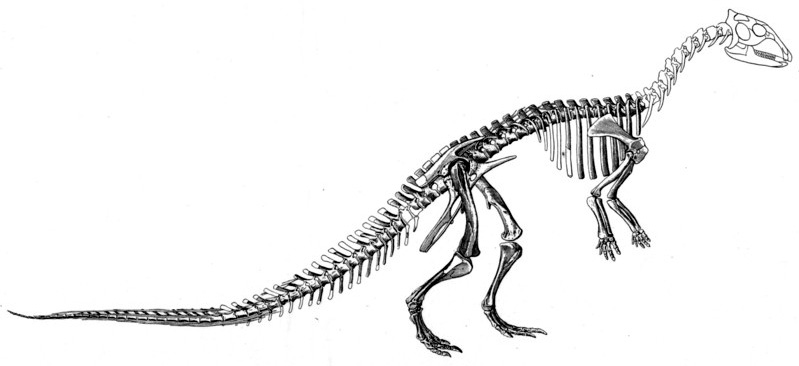|
Leptoceratops
''Leptoceratops'' (meaning 'small horn face') is a genus of ceratopsian dinosaur from the Late Cretaceous of North America. First found in Alberta in 1910, the type species ''Leptoceratops gracilis'' was named in 1914 by Barnum Brown for a partial skull and skeleton of two individuals found in the Scollard Formation of Alberta. Additional specimens found in the Scollard include one complete and two mostly complete skeletons together, uncovered in 1947 by Charles M. Sternberg. Specimens from Montana that were among the earliest referred to ''Leptoceratops'' have since been moved to their own genera ''Montanoceratops'' and ''Cerasinops'', while new specimens of ''L. gracilis'' include bonebed remains from the Hell Creek Formation of Montana and a partial skeleton from the Lance Formation of Wyoming. Together with related taxa, ''Leptoceratops'' is the eponymous genus of the family Leptoceratopsidae. ''Leptoceratops'' is known from more than ten individuals, all from Maastrichtian de ... [...More Info...] [...Related Items...] OR: [Wikipedia] [Google] [Baidu] |
Leptoceratopsidae
Leptoceratopsidae is an extinct family (biology), family of neoceratopsian dinosaurs from Asia, North America and possibly Europe. Leptoceratopsids resembled, and were closely related to, other neoceratopsians, such as the family (biology), families Protoceratopsidae and Ceratopsidae, but they were more primitive and generally smaller. Phylogeny Leptoceratopsidae was originally named by Franz Nopcsa von Felső-Szilvás in 1923 as a subfamily Leptoceratopsinae, and its type species is ''Leptoceratops gracilis''. Mackovicky, in 2001, defined it as a stem-based taxon and a family consisting of ''Leptoceratops gracilis'' and all species closer to ''Leptoceratops'' than to ''Triceratops horridus''.Makovicky, P.J. 2001. A ''Montanoceratops cerorhynchus'' (Dinosauria: Ceratopsia) braincase from the Horseshoe Canyon Formation of Alberta, In: Tanke, D.H. & Carpenter, K. (Eds.). ''Mesozoic Vertebrate Life''. Bloomington: Indiana University Press. Pp. 243-262. All previously published neo ... [...More Info...] [...Related Items...] OR: [Wikipedia] [Google] [Baidu] |
Montanoceratops
''Montanoceratops'' is an extinct genus of small ceratopsian dinosaur that lived approximately 70 million years ago during the latter part of the Cretaceous Period (geology), Period in what is now Montana and Alberta. ''Montanoceratops'' was a small sized, moderately-built, ground-dwelling, quadrupedal herbivore, that could grow up to an estimated in length and in body mass. Discovery and species The first fossil remains of what we now know as ''Montanoceratops'' were discovered on the Blackfeet Indian Reservation, west of Buffalo Lake, Montana in the St. Mary River Formation. It was collected in 1916 by Barnum Brown and Peter C. Kaisen of the American Museum of Natural History from terrestrial sediments that were deposited during the Maastrichtian Stage (stratigraphy), stages of the Cretaceous period, approximately 70 million years ago. After having mounted a reconstruction in 1935, Brown and his assistant Erich Maren Schlaikjer named it in 1942 as a new species of ''Leptoce ... [...More Info...] [...Related Items...] OR: [Wikipedia] [Google] [Baidu] |
Ceratopsian
Ceratopsia or Ceratopia ( or ; Greek: "horned faces") is a group of herbivorous, beaked dinosaurs that thrived in what are now North America, Asia and Europe, during the Cretaceous Period, although ancestral forms lived earlier, in the Late Jurassic of Asia. The earliest known ceratopsian, '' Yinlong downsi'', lived between 161.2 and 155.7 million years ago.Holtz, Thomas R. Jr. (2011) ''Dinosaurs: The Most Complete, Up-to-Date Encyclopedia for Dinosaur Lovers of All Ages,'Winter 2010 Appendix./ref> The last ceratopsian species, '' Triceratops prorsus'', became extinct during the Cretaceous–Paleogene extinction event, . ''Triceratops'' is by far the best-known ceratopsian to the general public. It is traditional for ceratopsian genus names to end in "''-ceratops''", although this is not always the case. One of the first named genera was '' Ceratops'' itself, which lent its name to the group, although it is considered a ''nomen dubium'' today as its fossil remains have no disti ... [...More Info...] [...Related Items...] OR: [Wikipedia] [Google] [Baidu] |
Cerasinops
''Cerasinops'' (meaning 'cherry face') was a small ceratopsian dinosaur. It lived during the Campanian of the late Cretaceous Period. Its fossils have been found in Two Medicine Formation, in Montana. The type species of the genus ''Cerasinops'' is ''C. hodgskissi''. ''Cerasinops'' was named and described by Brenda Chinnery and Jack Horner (paleontologist), Jack Horner in 2007 from a specimen (Museum of the Rockies, MOR 300) almost 80% complete, indicating a total body length of and a body mass of . It belonged to the Ceratopsia (the name is Ancient Greek for 'horned face'), a group of herbivorous dinosaurs with parrot-like beaks that throve in North America and Asia during the Cretaceous Period. Within this group, it has been placed as a basal (phylogenetics), basal member of Neoceratopia, although the description is variable; at one point, it is explicitly assigned to Leptoceratopsidae, but in others, it is considered a sister taxon to Leptoceratopsidae, or as a neoceratopsian ... [...More Info...] [...Related Items...] OR: [Wikipedia] [Google] [Baidu] |
Thescelosaurus
''Thescelosaurus'' ( ) is a genus of Ornithischia, ornithischian dinosaur that lived during the Late Cretaceous period (geology), period in western North America. It was named and described in 1913 by the Paleontology, paleontologist Charles W. Gilmore; the type species is ''T. neglectus''. Two other species, ''T. garbanii'' and ''T. assiniboiensis'', were named in 1976 and 2011, respectively. Additional species have been suggested but are currently not accepted. ''Thescelosaurus'' is the eponymous member of its family, the Thescelosauridae. Thescelosaurids are either considered to be basal (phylogenetics), basal ("primitive") ornithopods, or are placed outside of this group within the broader group Neornithischia. Adult ''Thescelosaurus'' would have measured roughly long and probably weighed . It biped, moved on two legs, and its body was counter-balanced by its long tail, which made up half of the body length and was stiffened by rod-like ossified tendons. The animal had a long ... [...More Info...] [...Related Items...] OR: [Wikipedia] [Google] [Baidu] |
Lance Formation
The Lance (Creek) Formation is a division of Late Cretaceous (dating to about 69–66 Ma) rocks in the western United States. Named after Lance Creek, Wyoming, the microvertebrate fossils and dinosaurs represent important components of the latest Mesozoic vertebrate faunas. The Lance Formation is Late Maastrichtian in age (Lancian NALMA, land mammal age), and shares much fauna with the Hell Creek Formation of Montana and North Dakota, the Frenchman Formation of southwest Saskatchewan, and the lower part of the Scollard Formation of Alberta. The Lance Formation occurs above the ''Baculites clinolobatus'' ammonite marine zone in Wyoming, the top of which has been dated to about 69 million years ago, and extends to the K-Pg boundary, 66 million years ago. However, the characteristic land vertebrate fauna of the Lancian age (which take its name from this formation) is only found in the upper strata of the Lance, roughly corresponding to the thinner equivalent formations such as the H ... [...More Info...] [...Related Items...] OR: [Wikipedia] [Google] [Baidu] |
1914 In Paleontology
References * Trexler, D., 2001, Two Medicine Formation, Montana: geology and fauna: In: Mesozoic Vertebrate Life, edited by Tanke, D. H., and Carpenter, K., Indiana University Press, pp. 298–309. 1910s in paleontology 1914 in science, Paleontology 4 ... [...More Info...] [...Related Items...] OR: [Wikipedia] [Google] [Baidu] |
Scollard Formation
The Scollard Formation is an Upper Cretaceous to lower Palaeocene stratigraphic unit of the Western Canada Sedimentary Basin in southwestern Alberta. Its deposition spanned the time interval from latest Cretaceous to early Paleocene, and it includes sediments that were deposited before, during, and after the Cretaceous-Paleogene (K-Pg) extinction event. It is significant for its fossil record, and it includes the economically important coal deposits of the Ardley coal zone. Lithology The Scollard Formation consists primarily of sandstones and siltstones, interbedded with mudstones and, in the upper portion, coal seams, as well as minor amounts of bentonite. The sediments were eroded from the Canadian Cordillera, and were transported eastward by river systems and deposited in fluvial channel and floodplain environments. Stratigraphy The Scollard is usually classified as the uppermost formation of the Edmonton Group, although some early workers included it in the overlying ... [...More Info...] [...Related Items...] OR: [Wikipedia] [Google] [Baidu] |
Triceratops
''Triceratops'' ( ; ) is a genus of Chasmosaurinae, chasmosaurine Ceratopsia, ceratopsian dinosaur that lived during the late Maastrichtian age of the Late Cretaceous Period (geology), period, about 68 to 66 million years ago on the island continent of Laramidia, now forming western North America. It was one of the last-known non-avian dinosaurs and lived until the Cretaceous-Paleogene extinction event, Cretaceous–Paleogene extinction event 66 million years ago. The name ''Triceratops'', which means 'three-horned face', is derived from the Ancient Greek, Greek words () meaning 'three', () meaning 'horn', and () meaning 'face'. Bearing a large bony neck frill, frill, three horns on the skull, and a large, four-legged body, exhibiting convergent evolution with bovines and rhinoceroses, ''Triceratops'' is one of the most recognizable of all dinosaurs and the best-known ceratopsian. It was also one of the largest, measuring around long and weighing up to . It shared the la ... [...More Info...] [...Related Items...] OR: [Wikipedia] [Google] [Baidu] |
Dinosaur
Dinosaurs are a diverse group of reptiles of the clade Dinosauria. They first appeared during the Triassic Geological period, period, between 243 and 233.23 million years ago (mya), although the exact origin and timing of the #Evolutionary history, evolution of dinosaurs is a subject of active research. They became the dominant terrestrial vertebrates after the Triassic–Jurassic extinction event 201.3 mya and their dominance continued throughout the Jurassic and Cretaceous periods. The fossil record shows that birds are feathered dinosaurs, Evolution of birds, having evolved from earlier Theropoda, theropods during the Late Jurassic epoch, and are the only dinosaur lineage known to have survived the Cretaceous–Paleogene extinction event approximately 66 mya. Dinosaurs can therefore be divided into avian dinosaurs—birds—and the extinct non-avian dinosaurs, which are all dinosaurs other than birds. Dinosaurs are varied from taxonomy (biology), taxonomic, ... [...More Info...] [...Related Items...] OR: [Wikipedia] [Google] [Baidu] |
Pachycephalosaurus
''Pachycephalosaurus'' (; meaning "thick-headed lizard", from Greek ''pachys-/'' "thickness", ''kephalon/'' "head" and ''sauros/'' "lizard") is a genus of pachycephalosaurid ornithischian dinosaur. The type species, ''P. wyomingensis'', is the only known definitive species. The possibly synonymous taxon, ''Stygimoloch'', might represent a distinct genus or a second species, ''P. spinifer''. It lived during the Maastrichtian age of the Late Cretaceous period in what is now western North America. Remains have been excavated in Montana, South Dakota, Wyoming, and Alberta. Mainly known from a single skull and a few extremely thick skull roofs (at 22 cm or 9 in thick), ''Pachycephalosaurus'' is estimated to have reached long and weighed . More complete fossils would come to be found in the following years. ''Pachycephalosaurus'' was among the last species of non-avian dinosaurs on Earth before the Cretaceous–Paleogene extinction event. The genus ''Tylosteus'' has be ... [...More Info...] [...Related Items...] OR: [Wikipedia] [Google] [Baidu] |
Braided Streams
A braided river (also called braided channel or braided stream) consists of a network of river channels separated by small, often temporary, islands called ''braid bars'' or, in British English usage, ''aits'' or ''eyots''. Braided streams tend to occur in rivers with high sediment loads or coarse grain sizes, and in rivers with steeper slopes than typical rivers with straight or meandering channel patterns. They are also associated with rivers with rapid and frequent variation in the amount of water they carry, i.e., with " flashy" rivers, and with rivers with weak banks. Braided channels are found in a variety of environments all over the world, including gravelly mountain streams, sand bed rivers, on alluvial fans, on river deltas, and across depositional plains. Description A braided river consists of a network of multiple shallow channels that diverge and rejoin around ephemeral ''braid bars''. This gives the river a fancied resemblance to the interwoven strands of a brai ... [...More Info...] [...Related Items...] OR: [Wikipedia] [Google] [Baidu] |











